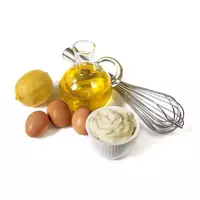Home mayonnaise

Mayonnaise became an integral part of the global culinary tradition hundreds of years ago. Nowadays, this cold sauce, which includes egg yolks, lemon juice, vegetable oil, salt, sugar, as well as mustard, has not lost its former popularity. There are just a huge number of types of product that differ in taste, aroma, color, as well as consumer characteristics and chemical composition of mayonnaise.
There are several versions that explain the origin of the name of the classic mayonnaise sauce. According to the first version, mayonnaise got its name thanks to the city of Maon, which was the capital of the island of Menorca in Spain. A descendant of the famous Cardinal Richelieu from the immortal creation of A. Dumas "Three Musketeers, " the Duke of Richelieu occupied the city in 175
7. However, the British constantly at war with the French attacked the island and besieged Menorca. Provisions in the besieged city ran out and the Duke of Richelieu constantly suffered from having to constantly eat turkey eggs, which the cook had in abundance.
Richelieu ordered the cook to come up with a new dish. One of the chefs suggested mixing the eggs, adding olive oil to them, which was also in abundance, spice and a little salt. The taste of the new Maon sauce (alsa mahonesa) fell on the duke to taste, and eventually spread throughout France. However, some researchers say mayonnaise is a product that was originally a type of famous and ancient aoili sauce. Nowadays, on the shelves of domestic grocery stores you can find a huge number of types of mayonnaise.
High-calorie and dietary, olive, classic Provencal or mayonnaise based on quail eggs, etc. The only type of mayonnaise that cannot be purchased in a home mayonnaise store is considered the best type of popular product. Home mayonnaise differs from the store version of mass production in its chemical composition and other equally important characteristics. However, the main difference between homemade mayonnaise and other types of product lies in the method of production.
The hostess or chef professional prepares homemade mayonnaise and puts a piece of her soul into the finished sauce. Mayonnaise for mass consumption is produced by a soulless machine. In addition, high-quality products are chosen to prepare homemade mayonnaise. Since it is precisely the quality of the initial ingredients and compliance with the recipe of the dish that depends on the taste, as well as the quality of homemade mayonnaise. In addition, the calorie content of homemade mayonnaise depends on the composition of the product.
We can say that only a high calorie level of homemade mayonnaise is a big disadvantage of the product. real connoisseurs and professional culinary experts call homemade mayonnaise "gentrified sauce, " since the product does not include flour. Another important factor is real and correct home mayonnaise is always beaten by hand.
In addition to the classic recipe of the dish, there is a sufficient number of subspecies or varieties of homemade mayonnaise. For example, homemade mayonnaise Provencal must add mustard, there is also onion, garlic, apple or orange homemade mayonnaise. In addition, mayonnaise with greens, horseradish or finely chopped gherkins. Recipes for homemade mayonnaise in cooking are enough, you can only make your choice.
homemade mayonnaise 568 kCal
Energy value of home mayonnaise (Ratio of proteins, fats, carbohydrates - ju):
Proteins: 5.3 g (21 kCal ~)
Fats: 58.7 g (~ 528 kCal)
Carbohydrates: 4.5 g (~ 18 kCal)
Energy ratio (bj | y): 4% | 93% | 3%
 Español
Español Français
Français Português
Português Русский
Русский 简体中文
简体中文 繁體中文
繁體中文 日本語
日本語 한국어
한국어 العربية
العربية Türkçe
Türkçe Қазақ
Қазақ Deutsch
Deutsch Italiano
Italiano Українська
Українська
